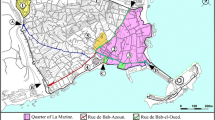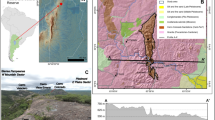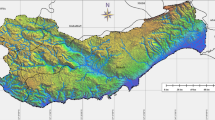Abstract
The cultural heritage of the different regions demonstrates the identity of individuals who have lived from the past to the present. Today, with the development of cities, some of these cultural assets have been forgotten or are being destroyed. Therefore, documenting this worthy heritage is vitally important for preserving, conserving, or introducing to the future. One of these assets is extensive and stretched out the historic water supply systems to access water from far distances for agricultural and residential targets. In this study, one of the remaining components of the water supply system of Dezful city in Iran has been studied. For this purpose, the remaining parts of the city’s water supply canal have been examined which was a part of a large complex. For modeling, this structure, a field study and a three-dimensional model based on multi-image photogrammetry have been carried out. Reverse engineering has been used by modeling a simulation of water movement in the canal to recognize designing the structure and using local materials of this historic built environment. In addition, the current condition of the canal is simulated for examining the deformation of structural changes over time. These analyses help to understand the designing process of the monument and how the natural environment and local materials have been exploited to create such structures. These findings could be of great help to restoring and refurbishing this extended and spread-out built heritage.














Similar content being viewed by others
References
Al-Marshudi AS (2007) The falaj irrigation system and water allocation markets in Northern Oman. Agric Water Manag 91:71–77
Asquith L, Vellinga M (2006) Vernacular architecture in the twenty-first century : theory, education and practice. Taylor and Francis
Attarian K, Safar Ali Najar B (2019) Vernacular and historic underground urban facilities and sustainability of cities case study: infrastructures of Dezful. J Cult Herit Manag Sustain Dev 9:2–23
Bakhteari S, Attarian K (2020) Geometry-based modeling for characterizing design and construction of Ourchin domes. J Build Eng 29:101199
Bazazzadeh H, Nadolny A, Attarian K, Safar Ali Najar B, HashemiSafaei SS (2020) Promoting Sustainable development of cultural assets by improving users’ perception through space configuration; case study: the industrial heritage site. Sustainability 12:5109
Borissova V (2018) Cultural heritage digitization and related intellectual property issues. J Cult Herit 34:145–150
de Luca L, Veron P, Florenzano M (2006) Reverse engineering of architectural buildings based on a hybrid modeling approach. Comput Graph 30:160–176
Deanna BM (2007) Digitizing for access and preservation strategies of the library of congress. First Monday. https://doi.org/10.5210/FM.V12I7.1924
Dostal C, Yamafune K (2018) Photogrammetric texture mapping: a method for increasing the Fidelity of 3D models of cultural heritage materials. J Archaeol Sci Rep 18:430–436
English PW (1968) The origin and spread of Qanats in the old world. Proc Am Philos Soc 112:170–181
Giaccone D, Fanelli P, Santamaria U (2020) Influence of the geometric model on the structural analysis of architectural heritage. J Cult Herit 43:144–152
Hillel D (1994) Rivers of Eden: the struggle for water and the quest for peace in the middle east. Oxford University Press, New York
Hoffman GJ, Howell TA, Solomon KH (1990) Introduction in management of farm irrigation systems. American Society of Agricultural Engineers, St. Joseph
ICOMOS (2013) Burra charter, the Australia ICOMOS charter for places of cultural, significance. SITES. AIIICOMA, Australia
Ipekoğlu B (2006) An architectural evaluation method for conservation of traditional dwellings. Build Environ 41:386–394
Letellier R et al (2007) Recording, documentation, and information management for the conservation of heritage places : guiding principles. Routledge
Lopez-Gonzalez L, van OteroCosca R, Gomez-heras M, Garcia-morales S (2016) A 4D GIS methodology to study variations in evaporation points on a heritage building. Environ Earth Sci 75:1113
Martínez-Garrido MI, Fort R, Gómez-Heras M, Valles-Iriso J, Varas-Muriel MJ (2018) A comprehensive study for moisture control in cultural heritage using non-destructive techniques. J Appl Geophys 155:36–52
Martins AN, Pereira AA, Forbes C, de Lima JLMP, Matos D (2020) Risk to cultural heritage in Baixa Pombalina (Lisbon Downtown)—a transdisciplinary approach to exposure and drivers of vulnerability. Int J Archit Heritage 15:1–23
Masciotta MG, Morais MJ, Ramos LF, Oliveira DV, Sánchez-Aparicio LJ, González-Aguilera D (2019) A digital-based integrated methodology for the preventive conservation of cultural heritage: the experience of heritagecare project. Int J Archit Heritage 15:1–20
McCarthy J (2014) Multi-image photogrammetry as a practical tool for cultural heritage survey and community engagement. J Archaeol Sci 43:175–185
Petrovič D, Grigillo D, Kosmatin Fras M, Urbančič T, KozmusTrajkovski K (2019) Geodetic methods for documenting and modelling cultural heritage objects. Int Archit Heritage 15:1–12
Rasti E, Talebi F, Mazaheri K (2019) Improvement of drag reduction prediction in viscoelastic pipe flows using proper low-Reynolds k-ε turbulence models. Physica A 516:412–422
Reale D, Noviello C, Verde S, Cascini L, Terracciano G, Arena L (2019) A multi-disciplinary approach for the damage analysis of cultural heritage: the case study of the St. Gerlando Cathedral in Agrigento. Remote Sens Environ 235:111464
Reisner M (1986) Cadillac desert : the American West and its disappearing water. Viking, New York
Resende PR, Afonso AM, Cruz DO (2018) An improved k-ε turbulence model for FENE-P fluids capable to reach high drag reduction regime. Int J Heat Fluid Flow 73:30–41
Rossato L, Massai P, Maietti F, Balzani M (2019) Digital tools for documentation and analysis of vernacular cultural heritage in Indian city centers. Int J Archit Heritage 15:1–11
Segreto T, Caggiano A, D’Addona DM (2013) Assessment of laser-based reverse engineering systems for tangible cultural heritage conservation. Int J Comput Integr Manuf 26:857–865
Smith L (2006) Uses of heritage. In: Smith C (ed) Encyclopedia of global archaeology. Springer, New York
Sojka RE, Bjorneberg DL, Entry JA (2002) Irrigation: an historical perspective. In: Lal R (ed) Encyclopedia of soil science. Marcel Dekker Inc, New York
Styliadis AD (2007) Digital documentation of historical buildings with 3-d modeling functionality. Autom Constr 16:498–510
Tabrizikahou A, Hadzima-nyarko M, Kuczma M, Lozančić S (2021) Application of shape memory alloys in retrofitting of masonry and heritage structures based on their vulnerability revealed in the bam 2003 earthquake. Materials. https://doi.org/10.3390/ma14164480
Thamir ZS, Abed FM (2020) How geometric reverse engineering techniques can conserve our heritage; a case study in Iraq using 3D laser scanning. IOP Conf Ser Mater Sci Eng 737:012231
The Venice Charter (1964) International charter for the conservation and restoration of monuments and sites (the venice charter 1964). IInd international congress of architects and technicians of historic monuments. ICOMOS, Venice
Varas-muriel MJ, Fort R, Gómez-heras M (2021) Assessment of an underfloor heating system in a restored chapel: balancing thermal comfort and historic heritage conservation. Energy Build 251:111361
Vellinga M, Oliver P, Bridge A (2007) Atlas of vernacular architecture of the world. Routledge, London
Wilson L, Rawlinson A, Frost A, Hepher J (2018) 3D digital documentation for disaster management in historic buildings: applications following fire damage at the Mackintosh building, the Glasgow school of art. J Cult Herit 31:24–32
Yoon GH (2020) Topology optimization method with finite elements based on the k-ε turbulence model. Comput Methods Appl Mech Eng 361:112784
Zekri S, Al-Marshudi AS (2008) A millenarian water rights system and water markets in Oman. Water Int 33:350–360
Author information
Authors and Affiliations
Corresponding author
Additional information
Publisher's Note
Springer Nature remains neutral with regard to jurisdictional claims in published maps and institutional affiliations.
This article is part of a Topical Collection in Environmental Earth Sciences on “Building Stones and Geomaterials through History and Environments—from Quarry to Heritage. Insights of the Conditioning Factors”, guest edited by Siegfried Siegesmund, Luís Manuel Oliveira Sousa, and Rubén Alfonso López-Doncel.
Rights and permissions
About this article
Cite this article
Attarian, K., Safar Ali Najar, B. Heritage documentation and structural analysis of historic water-supply canals. Environ Earth Sci 81, 100 (2022). https://doi.org/10.1007/s12665-022-10206-1
Received:
Accepted:
Published:
DOI: https://doi.org/10.1007/s12665-022-10206-1




